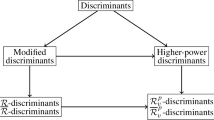Abstract
We show Laplacian algebras are maximal, and give applications to the Classical Invariant Theory of real orthogonal representations of compact groups, including: The solution of the Inverse Invariant Theory problem for finite groups. An if-and-only-if criterion for when a separating set is a generating set. And the introduction of a class of generalized polarizations which, in a certain class of representations (including all representations of finite groups), always generates the algebra of invariants of their diagonal representations.
Similar content being viewed by others
References
Derksen, H. and Kemper, G.: Computational invariant theory, volume 130 of Encyclopaedia of Mathematical Sciences. Springer, Heidelberg, enlarged edition, 2015. With two appendices by Vladimir L. Popov, and an addendum by Norbert A’Campo and Popov, Invariant Theory and Algebraic Transformation Groups, VIII
Draisma, J., Kemper, G., Wehlau, D.: Polarization of separating invariants. Canad. J. Math. 60(3), 556–571 (2008)
Ferus, D., Karcher, H., Münzner, Hans Friedrich: Cliffordalgebren und neue isoparametrische Hyperflächen. Math. Z. 177(4), 479–502 (1981)
Gorodski, C., Radeschi, Marco: On homogeneous composed Clifford foliations. Münster J. Math. 9(1), 35–50 (2016)
Helgason, S.: Groups and geometric analysis, volume 83 of Mathematical Surveys and Monographs. American Mathematical Society, Providence, RI, 2000. Integral geometry, invariant differential operators, and spherical functions, Corrected reprint of the 1984 original
Howe, R., Tan, Eng-Chye.: Nonabelian harmonic analysis. Universitext. Springer-Verlag, New York, 1992. Applications of \({{\rm {S}}L}(2,{{\bf {R}}})\)
Hunziker, M.: Classical invariant theory for finite reflection groups. Transform. Groups 2(2), 147–163 (1997)
Iltyakov, A.V.: Laplace operator and polynomial invariants. J. Algebra 207(1), 256–271 (1998)
Kapovitch, V. and Lytchak, A.: Structure of Submetries. arXiv e-prints, page arXiv:2007.01325, July (2020)
Kraft, H. and Procesi, C.: Classical Invariant Theory: A Primer. 1996. Lecture notes available on https://kraftadmin.wixsite.com/hpkraft
Lytchak, A., Radeschi, Marco: Algebraic nature of singular Riemannian foliations in spheres. J. Reine Angew. Math. 744, 265–273 (2018)
Mendes, R.A.E., Radeschi, M.: Singular Riemannian foliations and their quadratic basic polynomials. Transform. Groups 25(1), 251–277 (2020)
Mendes, Ricardo A. E., Radeschi, Marco: Laplacian algebras, manifold submetries and the inverse invariant theory problem. Geom. Funct. Anal. 30(2), 536–573 (2020)
Hans Friedrich Münzner: Isoparametrische Hyperflächen in Sphären. Math. Ann. 251(1), 57–71 (1980)
Hans Friedrich Münzner: Isoparametrische Hyperflächen in Sphären II Über die Zerlegung der Sphäre in Ballbündel. Math. Ann. 256(2), 215–232 (1981)
Neusel, M. D., Smith, L.: Invariant theory of finite groups. Mathematical Surveys and Monographs, vol. 94. American Mathematical Society, Providence, RI (2002)
Ozeki, H., Takeuchi, Masaru: On some types of isoparametric hypersurfaces in spheres. I. Tohoku Math. J. (2) 27(4), 515–559 (1975)
Ozeki, H., Takeuchi, M.: On some types of isoparametric hypersurfaces in spheres II. Tohoku Math. J. 28(1), 7–55 (1976)
Radeschi, Marco: Clifford algebras and new singular Riemannian foliations in spheres. Geom. Funct. Anal. 24(5), 1660–1682 (2014)
Rudin, W.: Principles of mathematical analysis. McGraw-Hill Book Co., New York-Auckland-Düsseldorf, third edition, 1976. International Series in Pure and Applied Mathematics
Gerald, W.: Schwarz. When polarizations generate. Transform. Groups 12(4), 761–767 (2007)
Schrijver, Alexander: Tensor subalgebras and first fundamental theorems in invariant theory. J. Algebra 319(3), 1305–1319 (2008)
Swartz, E.: Matroids and quotients of spheres. Math. Z. 241(2), 247–269 (2002)
Wallach, Nolan R.: Invariant differential operators on a reductive Lie algebra and Weyl group representations. J. Amer. Math. Soc. 6(4), 779–816 (1993)
Hermann Weyl. The classical groups. Princeton Landmarks in Mathematics. Princeton University Press, Princeton, NJ: Their invariants and representations. Fifteenth printing, Princeton Paperbacks (1997)
Acknowledgements
It is a pleasure to thank Harm Derksen for pointing out [22], which was the main inspiration for the proof of Theorem A, and Matyas Domokos for a simplification of the proof of Corollary E using [2]. We would also like to thank Alexander Lytchak and Matyas Domokos for suggestions that improved the exposition.
Author information
Authors and Affiliations
Corresponding author
Additional information
Publisher's Note
Springer Nature remains neutral with regard to jurisdictional claims in published maps and institutional affiliations.
The first-named author has been supported by the NSF grant DMS-2005373, and the second-named author by NSF 1810913.
Rights and permissions
Springer Nature or its licensor holds exclusive rights to this article under a publishing agreement with the author(s) or other rightsholder(s); author self-archiving of the accepted manuscript version of this article is solely governed by the terms of such publishing agreement and applicable law.
About this article
Cite this article
Mendes, R.A.E., Radeschi, M. Maximality of Laplacian algebras, with applications to Invariant Theory. Annali di Matematica 202, 1011–1031 (2023). https://doi.org/10.1007/s10231-022-01269-9
Received:
Accepted:
Published:
Issue Date:
DOI: https://doi.org/10.1007/s10231-022-01269-9




